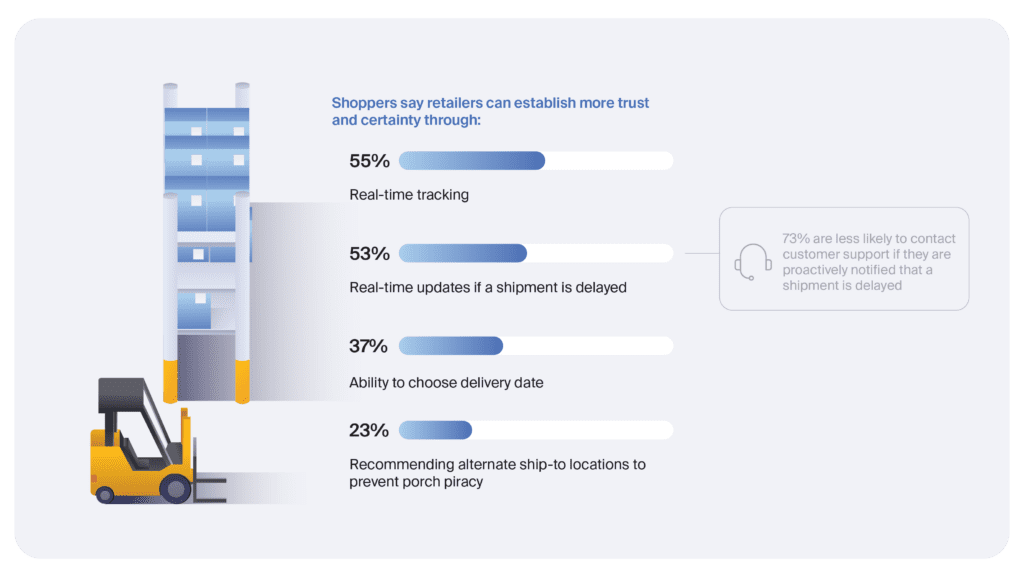A recent consumer survey found that transparent delivery tracking could be a growing factor in customer satisfaction, even competing with 1- to 2-day shipping. Keep reading for tips on how to improve the delivery experience for your ecommerce business.
When it comes to an excellent delivery experience for customers, both established and emerging brands often fixate on speed. However, a 2023 survey revealed that real-time delivery tracking is one of the top reasons why 90% of customers might be willing to forgo 1- to 2-day delivery.
As Ware2Go CEO Steve Denton mentions in the video above, delivery transparency could be key to increasing customer satisfaction. Here again, there are survey stats to support transparent delivery tracking:
- 43% survey respondents selected real-time tracking as one of the factors that would wane necessity for 1- to 2-day delivery
- 67% of respondents check delivery status daily
- 26% of respondents check delivery status multiple times a day
“When we fail to create transparency in the delivery tracking process…or be honest with delays,” Denton states, “customer satisfaction suffers.” Predictably, this poor experience can lead to negative reviews, lost sales, and customers leaving for competitors.
Let’s take a closer look at improving delivery tracking- both for customers and for the brands that sell to them.
Tip #1: Create transparency with delivery tracking early in the shipping process
With an eye on a better customer experience, tracking should begin during the pick, pack and ship process. Starting early creates transparency and confidence in your brand. Think of it from the customer’s point of view: getting an alert the moment an order has been fulfilled and is ready for carrier pickup, the more confidence they will have in the order’s subsequent journey.
Key moments for delivery updates include:
- The purchase has been received
- The item has been packed
- The item is picked up by the carrier
- Delivery tracking along the delivery route
- Proof of delivery
Next, we’ll expand on the importance of regular updates along the delivery journey.
Tip #2: Adopt real-time delivery tracking to build transparency and trust
Real-time delivery tracking allows customers to know exactly when and where their shipment is in the fulfillment and delivery process. This is typically a unique identifier with delivery tracking hosted online, like a personal website just for your customer and their package.
However, customers can also receive last mile carrier tracking updates via email or text messages. This includes proof of delivery which confirms a package has been dropped, sometimes with a photo to show the exact location.
Building transparency and trust also means updating customers about shipment delays. Although a delay is never ideal, this active outreach has real benefits for ecommerce brands. According to survey respondents, customers are 73% less likely to contact customer support if they are proactively notified that a shipment is delayed.
There are a number of delivery tracking solutions available—just be sure that whichever you choose integrates with your Warehouse Management System (WMS).

Tip #3: Use delivery tracking to build brand affinity
Providing delivery tracking updates early and often unlocks more customer satisfaction, but how those updates are delivered creates an opportunity to increase brand affinity. Similar to a stellar unboxing experience, delivery updates give ecommerce sellers the chance to inject their brand and delight customers.
Is your brand fun or playful? Adventurous? Soothing? Then you might be missing out if your delivery updates are plain, pithy, and technical.
Marketing teams will leap at the opportunity to bring out your brand voice- and create upsell and cross-sell opportunities.
Tip #4: Focus on internal reporting and transparency
While delivery transparency increases customer satisfaction, it can also play a critical role in emerging businesses’ operations. By increasing transparency internally- and with the right warehousing software- emerging brands can scale their business with peace of mind that operations can scale with it.
This includes questions around shipping rates and fill rates. Again, delivery starts at order fulfillment— and so too should delivery tracking.
When selecting a WMS, make sure that tracking numbers automatically sync with sales orders. Likewise, reporting should include important metrics like demand forecasting and inventory balancing to enable supply chain planning.
View the complete consumer survey to learn more about about how delivery preferences are changing:



